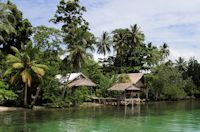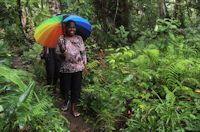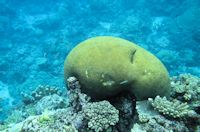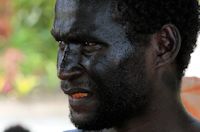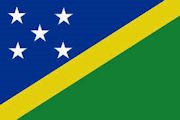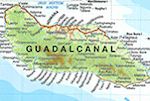Spear
Throwing on Santa Catalina
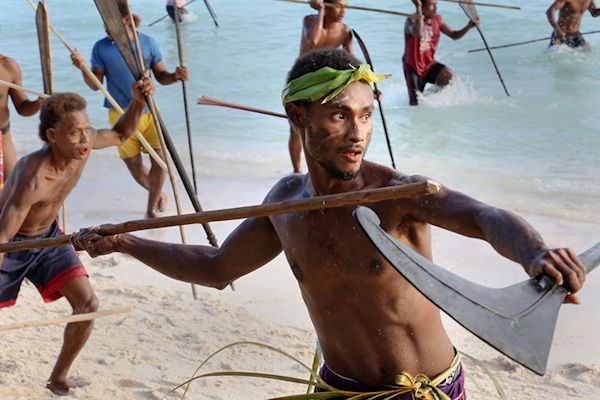
Pictures
of the Wogasia Spear Festival
By
Richard Moore
Deep
blasts of massed conch shells send pulses through the
blackness of the hot June night and push by us as if
they are spirits searching out the living to join them.
Despite
the humidity a chill passes down my spine. We heard
the conches being blown the previous day but, at 2am,
they sound very different.
They
are summoning the villagers of Aorigi to battle bad
spirits and disease by chasing demons off their island
during a ceremony known as Puta Wagona, the Beating
of the Ground.
The
biggest conch is known as Afuri and it sounds first.
Afuri had been brought from its resting place the previous
afternoon and washed - with the other conches - in the
sea. This symbolised the capture of the malign sea spirit.
Afuri
was then restored to his resting place to await his
star role.
At some time after midnight - when the Moon, Sun and
Morning Star are in a certain position - Wogasia begins
with a silent raid to capture Afuri.
Villagers
say the sea spirit within the conch must be surprised
and hence the need to silently approach it during the
darkest part of a moonless night, with no torches or
light.
Tradition
says that if the spirit is woken he will flee the shell
and the island will suffer famine and pestilence.
The
1.30am raid succeeds and the captured shell now leads
the calls for action.
More
pulses from the conches force their way through the
air.
They
are not single sounds but multiple short, yet somehow
languid, blasts. They are in laid-back Solomons tempo
– pahu, pahu, paaaah, pahu, pahu, paaaah, pahu, pahu,
paaaah - and are combined with shouts of encouragement.
Puta
Wagona is a major part of the annual Wogasia Spear Festival
on the remote island of Santa Catalina in the Solomon
Islands.
The
traditions of Wogasia - which means worship - focus
on cleansing and renewal for the villagers of Aorigi.
It
is a spiritual rebirth that sees locals cleanse the
island of bad spirits, rid themselves of hostility towards
anyone who has slighted them, and starting the new planting
season afresh.
Once
an important festival throughout the whole Makira region,
the villagers on Santa Catalina are the only Solomon
Islanders to have kept the tradition alive.
Elsewhere,
even just across the water on Santa Ana, Western churches
effectively closed it down mid last century. Its remoteness
has help Santa Catalina maintain Wogasia.
The
island is an hour-and-a-half flight south of the capital
Honiara, followed by a 30-minute jungle trek to a fishing
village and then a 20-minute longboat trip to its white
sands.
Visitors
to Wogasia are few - we are but a dozen or so travellers
to the festival - but we don’t remain outsiders for
long.
On
the beach, we are welcomed by the high chief and adopted
into the village.
This
is no act for tourists, it is a serious and solemn moment
that means I now have family on Santa Catalina. This
even entitles me to land on the island.
Back
in the 2am dark shouts count down - the Beating of the
Ground is about to begin.
We
are told to move into the central part of the village
to wait for the runners to pass by. Be careful and stay
back, we are advised, you don’t want to be covered in
what they throw at the runners.
We
do as we are bid and listen as the excitement builds
… then it is on.
To
uninitiated eyes the Beating of the Ground is a strange
mix of New Year’s Eve, Guy Fawke’s night, the Running
of the Bulls and a tribal riot.
Everywhere
there is shouting; thumps as the solid central cores
of palm fronds hit the ground and then huge bursts of
sparks as those same clubs hit burning coconut husks
sending clouds of red sparks into the air.
Screams
echo and re-echo, followed by yells of annoyance as
the runners are covered in all sorts of unpleasant-smelling
liquids thrown from the huts.
The
villagers have taken much of the day preparing pots
of fish-head water, yam peelings and other smelly stuff.
Dave,
an Australian living in Honiara, is hit by some liquid
and continues on no doubt wondering how long it will
take to remove the odour.
It is about 20 minutes of chaotic fun. Men, women and
children are all involved, laughing, yelling, whooping
in the darkness.
More
thumps, more screams, more excited laughter. Then it
stops.
The
villagers have beaten their spiritual adversaries and
it is time to walk to the beach and throw the frond
clubs into the sea. This banishes sickness and disease
as they do so and prepares the way for a good future
crop.
The
night is now calm again and still quite sticky. I need
water but, for the next 15 hours or so, that liquid
is banned.
It
is part of the cleansing process of a new beginning
and so we instead have fresh coconut water to drink.
For
three hours we sit on the beach and wait for sunrise.
Many
locals eat betelnut – the favoured mild intoxicant of
the Solomon Islands - or lie down and sleep. Others
talk and watch the sky eventually lighten in the east.
It
is a pretty view across the channel to Santa Ana island,
but now my focus is on the next highlight of the day
– the first spear fight between the men of the island’s
two tribes - the Amuea and Ataga.
Although
Wogasia is much more than throwing spears at someone
who has annoyed them over the past year, this is what
people really want to see.
The
sunrise fight of Faiarifa Wogasia is between teens,
uninitiated men and some warriors who are just getting
their aim straight for the big clash in the afternoon.
The
fighters – some dressed in the traditional costume of
long palm pal frond crown and skirt - stand about a
cricket pitch apart in two straight lines out into the
water. When the action starts it is full on.
Anyone
who thinks this is a game, or a bit of fun, has not
stood in the frontline and watched as blunted wooden
spears fly between the two groups.
The
power of the throwing is awesome and the accuracy spot
on.
One
warrior to my left is hit once.
A spear lands at my feet.
Then
the warrior is hit again. The blows clearly hurt him
and he holds his right shoulder for some time. Despite
this being the “junior” event it is very willing and
lasts about 10 minutes.
Small
axe-shaped shields are skillfully used to deflect the
spears and when several warriors look as if they are
about to get stuck in with their fists the chiefs call
it a day.
One
walks out into the middle of the warring factions with
his spear raised high. Eventually the fighting stops.
No one dares to ignore his commands.
As
soon as it is over it is as if the opposing tribes have
just finished a sports contest. While they didn’t file
by saying “good game, good game, good game” they greet
each other and then all walk along the beach together
towards the centre of the village.
The
warrior who was hit several times greets the man who
bested him. They smile and talk. They are cousins.
It
is now time for the women to walk up the hill to Faraina,
where they will have an intricate banana-leaf suit woven
around them.
The light-green costume will cover them from head to
ankle. Warriors who will take part in the main spearfight
also head up the mountain to cover themselves in mud.
Many
men have been banned from this year’s duel as they are
in mourning for family members who have died since the
last festival.
In mid-afternoon the peace of the hot day is shattered
when out from the jungle break scores of armed warriors
and boys carrying out a mock raid on Aorigi.
It
is a noisy affair as the mud-covered horde runs between
the outlying huts and pushes its way down to the beach.
The
chanting and yelling grow louder as the adrenalin of
expectation for the main spearfight courses through
their bodies.
Some
locals climb trees to get a better look at the action
which, when it kicks off, is a no-holds-barred event.
You
can hear the grunt as the fighters cast their spears,
the loud knocks as they are deflected, or the mutter
of pain when they strike home.
One
deflected shot flicks off into the crowd and hits a
guest in the chest. We later discover there may be something
to the belief that wounds done during the spear throwing
heal quickly and without medicine as there was not a
mark on his body.
Almost
as quickly as it starts the spear fight is stopped.
The
intensity is such that within five minutes the chiefs
end the contest. With the fighting over and peace restored
a score or so women, adorned in their banana-leaf costumes,
go into the ocean and are handed the conches.
They
sound them for a final time and release the spirit to
the sea. The conches then are stored for next year’s
Wogasia.
That
night the village gathers in groups to feast, listen
to bamboo band music and watch dancers.
They are all looking forward to a new year filled with
plentiful food from both ocean and field.
As
one of the very few “former outsiders” to take part
in the festival, it has been an honour to join in Wogasia.
The
next time I return I will, as part of a tribe, be able
to take to the sands of battle on Santa Catalina.
